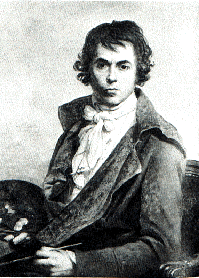
Grade 10 | Lesson 23
Dean of Students: dean@theschools.com
Tech Services: tech@theschools.com

Grade 10 | Lesson 23
Dean of Students: dean@theschools.com
Tech Services: tech@theschools.com
Fine Arts
Lesson Overview
Global Art Connections I
• Jacques Louis David
![]()
Global Art Connections I
Jacques Louis David
 Jacques Louis David (pronounced dä-vëd’) early turned his back on the frivolous rococo manner, looking instead to antiquity for inspiration. Following the ideals of Nicolas Poussin, to whom the artist candidly admitted he owed everything, David sought to reduce classical principles to their barest, unencumbered essentials. In this endeavor he observed with avid interest the neoclassicism propounded by Johann Winemann and the illustrations of antiquity found in paintings of Anton Raphael Mengs. An outspoken political firebrand, David espoused the cause of the French Revolution and under the Convention held sway as virtual dictator of the arts; later when Napoleon came to power, he acted willingly as his artistic spokesman.
Jacques Louis David (pronounced dä-vëd’) early turned his back on the frivolous rococo manner, looking instead to antiquity for inspiration. Following the ideals of Nicolas Poussin, to whom the artist candidly admitted he owed everything, David sought to reduce classical principles to their barest, unencumbered essentials. In this endeavor he observed with avid interest the neoclassicism propounded by Johann Winemann and the illustrations of antiquity found in paintings of Anton Raphael Mengs. An outspoken political firebrand, David espoused the cause of the French Revolution and under the Convention held sway as virtual dictator of the arts; later when Napoleon came to power, he acted willingly as his artistic spokesman.
A friend of Robespierre, David nearly accompanied him to the guillotine when the Jacobin fell from power in 1794. Imprisoned for 7 months, first at Fresnes and then in the Luxembourg, the artist emerged a politically wiser man, It was while in prison that David executed one of his rare landscapes: the Gardens of the Luxembourg (1794), a view from his prison window. By 1798 he was busy on what he proclaimed his masterpiece, the Rape of the Sabine Women. The subject matter, derived from the classical legend described by Livy in which the Sabine women intervened in the battle between their fathers and brothers and their Roman husbands, represented a calculated appeal by David to end the internecine conflict that had ripped France asunder; further, the vast canvas was planned as a sort of manifesto proclaiming the validity of the antique.
It was at this time that David met Napoleon Bonaparte, in whose person he recognized a worthy new hero whom he promptly proceeded to glorify. The Emperor in turn realized the rich potential of David as a propagandist born to champion his imperial regime, and it was -probably with this in mind that he invited the artist to accompany him on his Egyptian campaign; that David declined to go was surely due only to the fact that he was then deeply absorbed in the creation of his avowed masterpiece, the Sabine Women. Named "first painter," David executed a number of portraits of the Emperor, the most notable of which is probably that entitled Bonaparte Crossing the St.
Bernard Pass (1800), in which the subject was idealized in physical stature and romanticized as the effortless man of action. Among the major commissions granted David by the Emperor were the colossal scenes treating specific episodes of his reign. The best-known of these are the Coronation of Napoleon and Josephine (1805—1807), containing over 100 portraits, and the Distribution of the Eagles (1810).
Though David would have preferred to be remembered for his history painting, he was at his best as a portraitist. Certain of his portraits, such as Madame Sériziat and Her Daughter and Monsieur Sériziat (1795), are done with an incredible directness and thus retain a freshness and vivacity not often encountered in David’s more serious works. His unfinished portrait Madame Récamier (1800), with the subject shown in long, loosely-flowing robes, vaguely reminiscent of the antique, summarizes the studied elegance of the neoclassic age.
With Bonaparte’s defeat at Waterloo and the subsequent restoration of the Bourbons, David tried to retreat into quiet seclusion, but his earlier political affiliation and, more particularly, his actions during the heat of the Revolution were not calculated to warm his relations with the new rulers. He was declared persona non grata and fled to Switzerland. A short time later he settled in Brussels, where he continued to paint until his death on Dec. 29, 1825. His family’s urgent request that his ashes be returned to France was denied. He was buried amidst great pomp and circumstance in the church of SteGudule in Brussels.